Go to Page
Sir,
The Irish name of Ardrahan Parish which lies in the barony, of Dunkellin, about 4½ miles N. by East from the town of Gort in the County of Galway, is Ard Rathain, which may signify the height of the fort {or rath}.
In the word Rathain, as locally pronounced, the vowels are short, in both syllables, which seems to shew that it may not be Ráthan, the primary diminutive of ráth a fort which has the a long in both syllables. Perhaps therefore, it may be from the old Irish word ráthan ferns as well as cuil. Rathain now Coolrane, which is translated Secessus filicis in the Tripartite Life of St. Patrick.
The rath in which the name originated is not pointed out by the inhabitants of the place; nor is there such a feature in existence, as far as I could learn, at present about the village of Ardrahan, that might be considered as the one which became the designative. The village is certainly at the original locality which bore the name; for it is on the declivity of a rising ground, the highest part of which, is occupied by an old church, in ruins; by the Parish Church close by it, a small remnant of a round
(tower) and an old Castle, which stands in ruins, a short distance to the North East of the Church yard, within a square fortification. There are some, who conjecture it was from this fort the place took the name; but this conjecture does not deserve notice.
There is but a very small portion of the round tower {locally Claictheach} of Ardrahan now to be seen. It is situated in the S. West corner of the Church yard, where it is included in the enclosing wall, and is 6½ feet in height on the outside and 3½ feet on the inside. It was a construction of large stones and cement of lime and sand mortar. The wall is 4 feet 2 (or 3) inches thick, and the portion remaining appears thus, in position and extent.
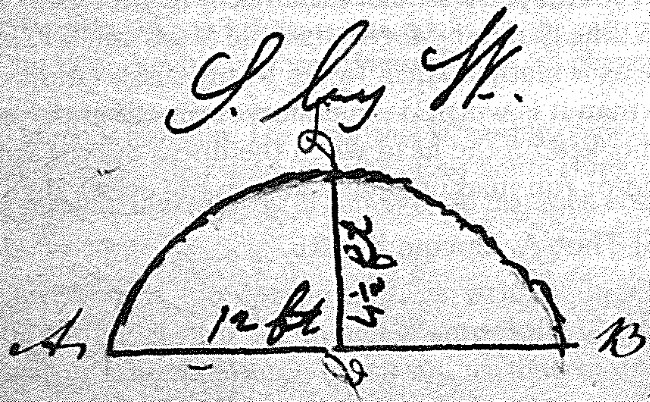
Dutton in his Statistical Survey under the heading 'Round Towers', p. 467, having stated that he discovered one at Murrough {this is the Rosscam round tower}, about two miles Southward of Galway on the Sea coast, which he believed escaped the research of Dr. Ledwich and Dr. Beaufort, says that he also discovered the remains of another very small one near the Church of Ardrahan, which he believed, also escaped their notice. He remarks that it is the smallest one, he ever saw.
The Church in ruins, appears (a) very modern one. It was seemingly used as the Parish Church previously to the building of the present one.
The fort within which the Castle stands in ruins, was made of earth, and was entrenched around. The ditch on the East and partly on the South side, is still visible. The inner mound {agger} is seen on the North, & East, and partly on the South and S. West sides. The only part remaining of the mound on the outside of the ditch, is that which enclosed it to the East.
Inquisition taken before John Crofton Esqre. at Athenry
1st October 1584, found that Rickard 2nd Earl of Clanrickard died 24th July 1582 seized in fee and fee taile of several lands &c., along (with) which, he was in possession of the Castle of Ardrahan and 3½ qrs.
69 (In RH and lower margins:] In ihe word Rathain, as localry pronounced, the vowels are short, in both syllables, which seems to shew that it may not be iatan, the primary diminutive of 1^.kCi a fort which has the A long in both syllables. Perhaps therefore, it may be from the old Irish word wtanfCflts as well as cull. Wam now Coolrane, which is translated Secesstts filicis in the Tripartite Life of St. Patrick.
See Inquisition taken at Galway 20th March 1608, before Geoffrey Osbaldstone Esqre., &c. This Inquisition of A.D. 1608, found that Ulick Bourke 3d Earl of Clanrickard was seized in fee and fee tayle of several lands, and also of Ardrahan {1 qr.}, the Castle of Ardrahan {& 1 qr.}.
The following notices of Ardrahan, are to be found in the Annals of the Four Masters.
A.D. 1225. Upon the departure of the great armies of the English from Hugh, the son of Charles the Red- handed, O'Flaherty, the son of Mortogh (O'Conor} and all the other nobles rose up against him and joined the sons of Roderick; whereupon Hugh despatched messengers and letters to the Lord Chief Justice to make this Circumstance known to him and to request additional forces. This request was by no means an ineffectual one, for the English answered him cheerfully and expeditiously, and well were they rewarded for
the expedition they had made, for their spoils were great and their struggle was small. The English of Leinster were sent to Hugh under the conduct of William Cruce and the sons of Griffin. Upon the arrival of these forces, Hugh marched Westwards across the Causeway against the sons of Roderick, and proceeded to Hy-Diarmada, where he had heard they were stationed without troops, for their friends had not as yet reached them, and he sent Felim his brother and
others of the Chiefs of his people and a great body of the English soldiers into Hy-Fiachra Aidhne to plunder O'Heyne. They were a night encamped at Ard-rathain for the purpose of plundering the Country early the next morning. O'Flaherty and the son of Mortogh O'Connor, who were on their march to aid the sons of Roderick, having obtained intelligence that the English were proceeding to plunder their partizan Eoghan O'Heyne and were stationed at Ard Rathain, did not neglect their friend, for with one mind and accord they marched until they had arrived at a place very near the English where they delayed, and having
held a council, came to the resolution of first sending Tuathal, the son of Mortogh, and Teichleach O'Dowd with numerous forces into the Town, while O'Flaherty and the sons of Mortogh (O'Connor} were to remain with their forces outside. Tuathal and Taichleach, with their soldiers, marched courageously and boldly into the Town, and made a vigorous and desperate attack upon the English there. The English were put to flight East and West, and were pursued Eastwards. The Constable of the English received two wounds, one from the arrow of Tuathal
and another from Taichleach which left him lifeless. As to the English who fled westwards from the Town; they were met by O'Flaherty and the sons of Mortogh, but it happened to their misfortune that the English routed them immediately. On this occasion, Mahon the son of Hugh, who was son of Connor Moinmoy, Gilchreest the son of Dermott, Niall the son of Ferrall O'Teige were slain; but the man who had slain Niall, i.e. the brother of Colen O'Dempsy was slain himself also. As to the sons of Roderick they parted the next morning from
O'Flaherty and their other friends and proceeded Southwards to Druim-Ceannanain whither they were pursued by Hugh, the son of Charles the Red-handed.
A.D. 1258. A great war broke out between the English and Conn O'Brian in which Ardrathain and Kilcolgan were burned as were also much Corn and many villages.
A.D. 1260. MacMaurice {Fitz Maurice} marched with an army into Thomond against Connor O'Brien. O'Brien attended by the Chiefs of his people, met him at Coill-Berain; the English were speedily defeated with the loss
of David Prendergast, a most able bodied Knight, Failgeach, Parson of Ardrahin, Thomas Barrett and others not mentioned.
A.D. 1265. The Castles of Lough Mask and Ardrahin were taken by Mac William {De Burgo}.
A.D. 1599. See Clanrickard at this year in the account of the territories of the County of Galway. I have not the words of the passage.
An old Castle stands in Castle-Taylor townland in this parish. Castle Taylor built in 1802 is attached to it.
In Drumharsna South townland {Druim Tharsna}, there is (also) an old Castle in ruins. And there is one in ruins in Ballymaquiff townland.
There is an old burying place in Lisheeneynaun T.L. {Lisín Eidhreáin} where, I was informed, there is some portion of an old Church, still visible.
It is remarked in the Name-book that the ruins of an old Castle and the ruins of an Abbey, and grave yard, lie in the townland of Mannin (Manainn).
I could not when at Gort make time to go see these ruins. I cannot tell what state they are in.
KILTARTAN PARISH
The name of this Parish, is pronounced Cill Tartain, which signifies the Church of Tartan {or Tortan}. Is this name given as the name of a Saint in our Eccl: hist:?
Kiltartan old Church, is 65 feet long and 25 feet broad. There is a window on the East gable, which on the inside is very little more than 4 feet broad in the lower part; is no less than 6 feet high, and exhibits mason-work of this form in the upper part.
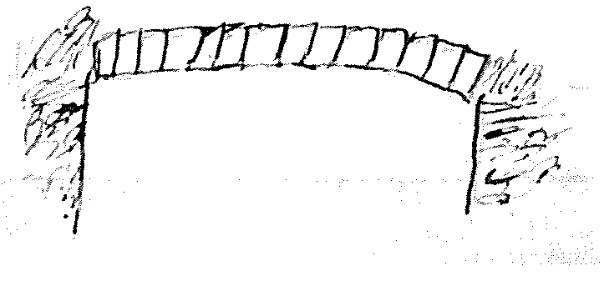
The window on the outside is 9 feet 2 inches from the ground; is 4 feet broad, and no less than 6 feet high.
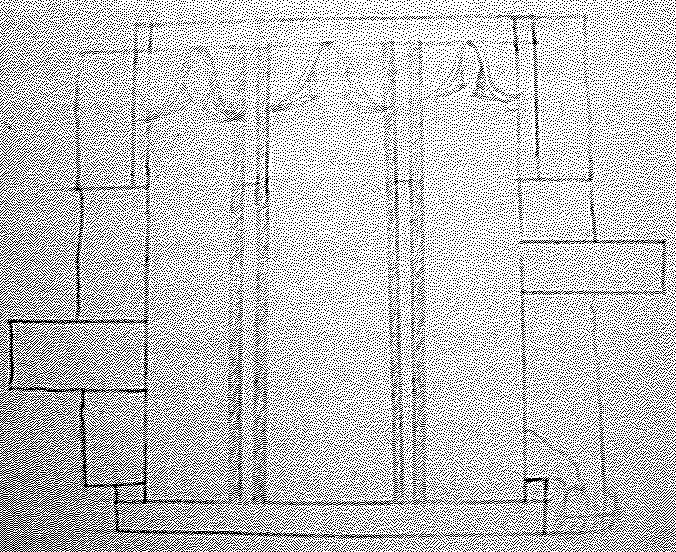
This window is closed on the outside with mason work.
At the distance of 5 feet 7 inches from the East gable, there is a window on the South side wall, which on the inside is 6 feet from the ground, 3 feet broad in the lower part, 4½ feet high, quadrangular, and narrowing gradually outwards to a breadth of 10 inches. It is 8 feet from the ground on the outside, and may be said to be 4 feet high. It is partly covered with ivy, which being matted at the top, prevents a clear view of its form.
At the height of 5 feet 7 inches from the ground, (on the inside) is, on the same wall, between this and the East gable, a window 3 feet 10 inches broad in the lower part, and no less than 8 feet high. Ivy has encroached into the upper part, where it appears, the window was arched with mason work. It is so thickly covered with ivy on the outside that it is impossible to ascertain its (original) height or form.
On the North side wall, at the distance of 9 feet 7 inches from the west gable, is a door, of chiseled stones 3 feet, 7 inches broad at the ground and about 7 feet, 5 inches high; and pointed at top.
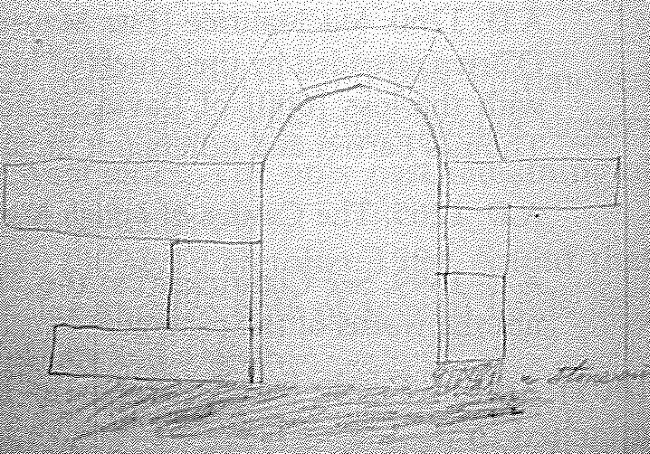
On the same wall is a window, 14 feet from the door towards East gable, 6 feet 4 inches from the ground inside, 3 feet 6 inches broad in the lower part; the top is demolished. On the outside it is 6 feet 6 inches from the ground, is 6 inches broad where it retains its original breadth, and is no less than 5 feet high.
In the inside of the Church within 5 feet 7 inches of the East gable is placed in the thickness of the North wall, a stone altar, with a pointed arch of ornamentally cut stones, rising over it.
The upper part of the West gable is covered with ivy; a breach on it is obvious. The part towards the South side wall is falling to destruction, being much lower now than the side to the North.
This Church it is said, was used as a Protestant Church.
Fig. 86
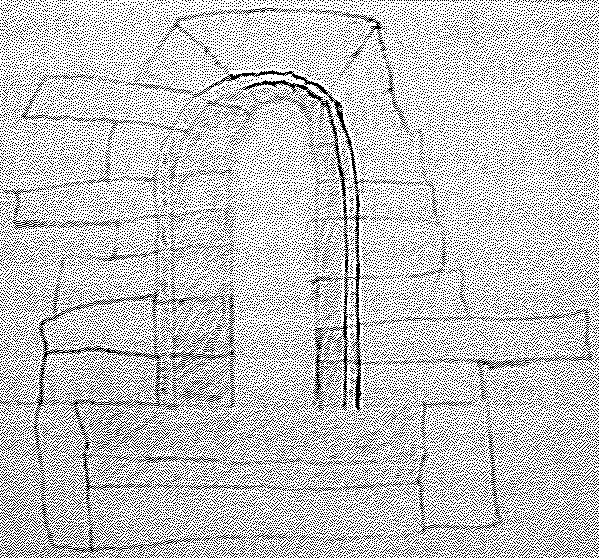
Kiltartan gave name to the barony in which this church is situated; (and which was (or is) one of the six baronies composing the territory of Clanrickard, according to) Inquisition taken at Galway 20th March 1608, before Geoffrey Osbaldstone Esqre. {and others} by the oaths of lawful men who say that Ulick Bourke first Earl of Clanrickard before his creation by Henry 8th was seized in fee by descent from his ancestors, of the territory of Clanrickard, consisting of six baronies viz. Loughreegh, Dunkellyn, Kiltartan or Kiltaraght, Clare, Athenry and Leitrim.
In this same Inquisition it is afterwards stated that Rickard 4th Earl of Clanrickard, was seized of a yearly rent of 20 shillings out of Kiltaraght in the same County {i.e. Galway}.
The town of Gort, which partly stands in this parish, is called locally, Gort Inse Guáire in Irish; a name signifying the field of the island of Guaire.
Gort-inse-Guaire occurs in the Annals of the Four Masters at the following years.
1571. John the son of Gilduff, who was son of Dermott, who had been styled the O'Shaughnessy from the time of the death of his father until this year, was deprived of that title and also of Gort-inse-Guaire by his fraternal uncle, Dermott Reagh, the son of Dermott, for he was virtually the senior.
1573. Morogh the son of Dermott, who was son of Morogh O'Brien, was slain by Ulick Burke, the son of Richard, who was son of Ulick na g-ceann and by O'Shaughnessy, viz Dermott the son of Dermott, who was son of William, who was son of John Boy. O'Shaughnessy was the man, who gave him
his death blow. John Burke afterwards deprived O'Shaughnessy of Gort-insi-Guaire in revenge of the homicide of his Kinsman.
1597. O'Donnell {Hugh Roe, the son of Hugh, who was son of Magnus} encamped in Breifny in Connaght to the West of Sliabh da en, after having plundered the friends of O'Connor. Here he stopped until he should be joined by all his forces in every direction. When all had assembled, which was in the end of the month of January, they marched into the territory of Hy-Noillealla {Tir-errill} thence into Corran,
through Machaire Chonnaught into Clan Conmhaighe and Hy-many. Having arrived at the very entrance of Hy-Many, O'Donnell sent forth several strong marauding parties to Tuath an Chalaidh and the upper part of the territory, who brought many herds of Cattle and other spoils to him to Athenry. The warders of this town attempted to defend it, but their efforts were useless. O'Donnell's people applied fires and torches to the strong gates of the town and carried with them large ladders by means of which they ascended to the parapets of the walls.
From the tops of the walls, some leaped into the Streets of the town and opened the gates for those who were outside. They all then proceeded to demolish the stone houses and the houses of defence, which they stript of all their goods and valuables. They remained that night in the town. It would be difficult to enumerate the quantity of copper, iron, clothes and vesture they carried from the town, on the following day. From the town also O'Donnell sent forth marauding parties to plunder Clanrickard on both sides of the river; these pillaged and ravaged the entire tract of country
lying between Leathraith and Seanchomhladh. The remaining part of his army burned and ravaged the territory from Athenry to Rath-Goirrgin westwards to Rinnmil and Meathruighe and to the very gates of Galway and also burned Teagh-Brighde at the gate called Spairri.
O'Donnell pitched his camp for that night between Uaranmore and Galway precisely at Cloch an lingsigh and on the following morning went to the Monastery of Cnoc near the gate of Galway and trafficked with the inhabitants
of the Town exchanging a portion of his spoils for some of their various wares and rich apparel. He then resolved upon returning back, though had he not been impeded by the heavy burden and great incumbrance of his many spoils, he would have advanced onwards directly to Gort-insi-Guaire in Kenel Aodha na h-Echte. He marched back the same road with his forces and spoils, through the very middle of Connaght, and made no delay until he had pitched
his camp in Calry to the East of Sligo.
A.D. 1600. When Dermott the son of Dudley who was son of Tuathal O'Conor, left the country of the Geraldines, after the Earl of Desmond {James the son of Thomas} whom he had captured, was forcibly wrested from him, he proceeded to Cluainte in the Country of the O'Conor Roe, and obtained protection from the Lord Chief Justice, who was doing, his duty in the Queen's Service in Leinster and Ulster in the autumn
of this year. When this young Earl of Desmond, James the son of Garrett of whom we have spoken arrived in Ireland, he sent for Dermott, for Dermott had married the Earl's sister while on his military sojourn in the Country of the Geraldines the year before, and some say that she was the cause of the Capture of James, the son of Thomas, in order that her own brother might the more easily attain to the title. As soon as Dermott had received the Earl's letter he set out on his way to
meet him by the permission and protection of the Lord Chief Justice and the president of the two provinces of Munster, but as he was passing in a Southern direction through the province of Connaght with the intention of crossing the Shannon and proceeding to Límerick, he was pursued by Theobald na long, the son of Richard an Iarainn and by David, the son of Ulick an timchill who bore enmity towards him. They overtook him
in the vicinity of Gort-insi-Guaire, and finding him attended only by a few troops, they beheaded him.
James Fraser in his Guide through Ireland, gives the following description of Gort.
The thriving and prettily small town of Gort stands on the borders of the County of Galway, in the plain lying between the hills of Burren on the west, and those in the barony of Loughrea on the East. It is watered by a stream which bears the surplus of several small loughs above the town into the bay of Galway, at Kinvara harbour, environed by some extent of good, though bleak and Craggy lands, and considerably beautified by the plantations and other improvements connected with the residence of the noble proprietor, Viscount Gort.
It is pleasing to observe that in the alinement of the streets, and building of the houses, considerable attention has been paid to order and Convenience. The shops look smart, and supply the country around with every necessary. For this kind of trade, Gort is well circumstanced, being twelve miles distant from any other town.
An old Castle stands in ruins in the townland of Castletown in this parish. It appears from the ruins on the ground, to have had a very extensive bawn. Two towers remain as yet at one extremity of the ruin.
In Cnoc Chille Dá, {Knockilladááh,} the Irish name of the place now called Newtown, there is a burying place for children. (Some place this burying place in Knockdrummore.)
KILTHOMAS PARISH
This parish is bounded on the N.W. and N.E. by the parish of Ardrahan, in the baronies of Loughrea and (&) Kiltartan, and Dunkellin, on the E. & S.E. by those of Ardrahan and Killeenadeema BY. of Loughrea, on the South by that of Feekle, BY. Tulla, Co. Clare, & on the W. by those of Kilbeakanty & Kiltartan in the Barony of Kiltartan - {Name-book No. 1, p. 1}. The Irish name of this parish is Cill Tómais, i.e. Church of S. Thomas.
The East and West gables of Kilthomas old church, were entirely demolished; of the South side wall 34 feet in length remain.
On this wall, there is a window near East gable, (which on the inside, is 4 feet from the ground &) 4 feet broad in the lower part, and 12(?) feet high. It was circularly arched at top with masonwork of rudely cut stones. The arch was broken down at top. The window on the outside is 6 feet from the ground, 7 inches broad, and 6 feet high.
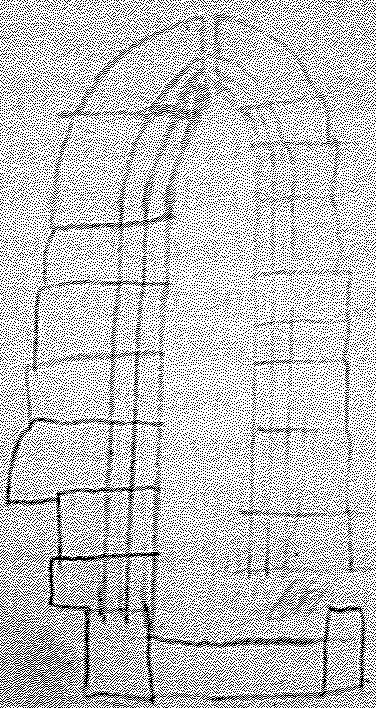
On the North side wall near East gable there is a window, (on inside) 2 feet from the ground, 5 feet broad in the lower part, and having a circular arch of rudely cut stones, 12 or 13 feet high. It is 7 feet from the ground on the outside and 7½ inches broad.
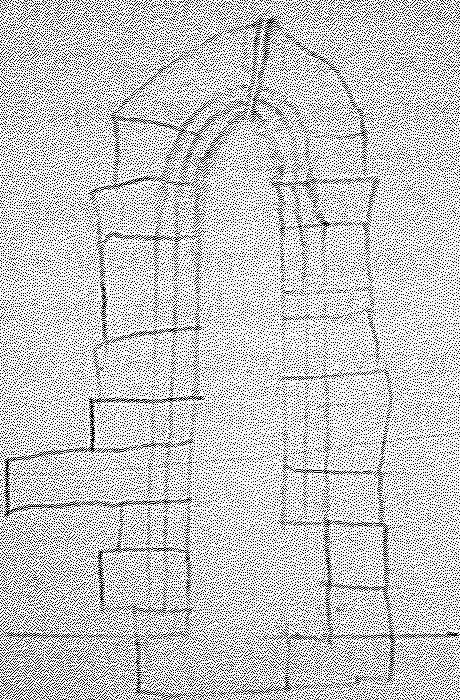
Of the North side wall, 58 feet in length remain. At the distance of 15 feet from the West gable, there is on it, a pointed archway of mason work, the sides of which are battered. It is now more than 6 feet broad, and about 12 feet high.
The breadth of the church is 25 feet. It was apparently 75 feet in length. On the part of the South side wall (that stood) near West gable, there were observable, marks of fire, supposed to have been effected by conflagration, which is said to have taken place (in) the time of Cromwell. This part of the wall totally fell to destruction.
St Peter's Well, is lying in Kilmore {Coill Mór} Townland. There was a Chapel here which was converted about 5 years ago to a barn.
In Drummore (T.L.) {Druim Mór} there is a burying place, where a Chapel of ease, stood some time ago.
There was a Castle called Caislean na g-Cailleachadh Dubha, in Doonally - Dún Áille - townland, which was totally destroyed.
In Ballylee - Baile Ui Laoigh - townland, there was a castle.
An old Castle lies in ruins in Rahaly townland - Rath hÁl - of which the Donnellans were proprietors.
[In left-hand margin: Capt S.]
KILBEAKANTY PARISH
This parish lies in the Barony of Kiltartan, 2½ miles East by North from the Town of Gort.
Its Irish name is Cill Beúcanta - which signifies the Church of S. Beúcanta. Does this name occur in any of the Ecclesiastical documents?
The old church of this parish, is 53 feet long and 21 feet broad; the East gable, was destroyed, except two small portions of it, the one attached to the South side-wall, and the other to the North wall. On the South side wall within 6 feet of the East gable, is a window, (on the inside) 2 feet 10 inches from the ground, 3 feet 8 inches broad in the lower part, and 4 feet
9 inches high. It is quadrangular on this side and a flag stone crosses it at top. On the outside, it is 5 feet from the ground, 6 inches broad, 3 feet 8 inches high, and pointed.
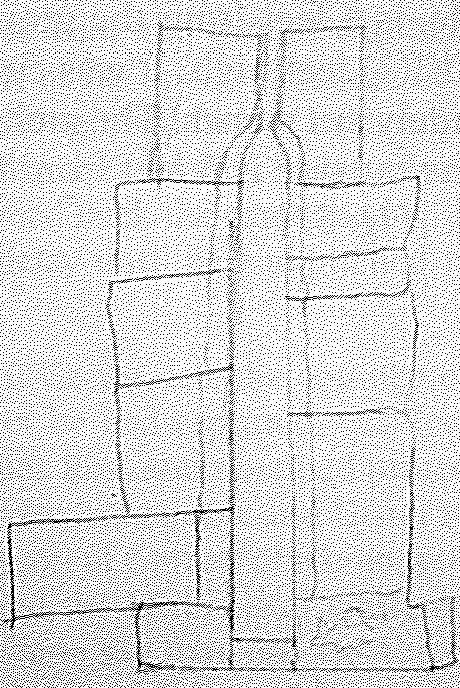
The door way was on the South side wall at the distance originally of 14 feet from the West gable. The original breadth cannot be ascertained, as there is a breach in the place now; a flag stone 5½ feet from the ground {original height of the door}, and 3 feet 2 inches long, crosses the upper part. The form was quadrangular. The west gable and North side wall are covered with ivy.
There is a burying ground for children in Killafeen - Cill a Fíon - townland. Tobermacduagh - Tobar 'ic (Mhic) Duach - lies in Rakerin townland - Rath Ceírín.
In this letter, the parishes of Ardrahan, Kiltartan, Kilthomas, and Kilbeakanty, are noticed and the several remarkable old monuments in them, are adverted to. This is the finishing of my part of the County of Galway.
Servt.,
T. O'Conor